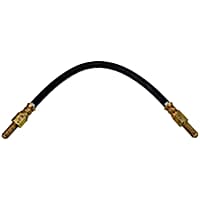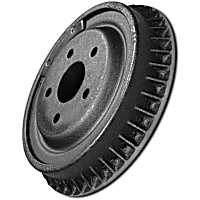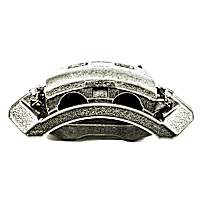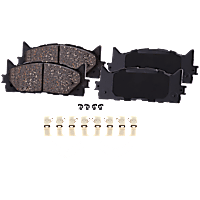As a vehicle owner, you need to familiarize yourself with the braking system in your car, truck, or SUV. How do you know if your brakes are running properly? How can you tell if your brakes need to be replaced? What can you do to prolong the service life of your brake components? This brief guide will answer these questions and help you differentiate good brakes from bad brakes.
What Are the Characteristics of a Healthy Brake?
Brakes work by creating friction in order to slow down or stop a moving vehicle.
A moving vehicle is an example of kinetic energy. Applying the brakes converts kinetic energy to heat energy, and it happens as the pads “pinch” the spinning rotors that are married to the wheels, or when the brake shoes move out to make contact with rotating brake drums that are just as married to the wheels. Many newer pickups have drum brakes in the rear again, although disc brakes seemed to be replacing drum brakes.
For brakes to generate friction, a special braking material (aramid, asbestos, etc.) is pressed against a secondary material that rotates along with the wheel. This secondary material may come in two forms: brake drums and disc brakes.


Brake Drums
Often found in older vehicles but now beginning to reappear on some newer platforms used for the rear brakes, brake drums contain two curved shoes that are lined with friction material. When the wheel turns, the shoes barely touch the surface of the drum. However, when the brakes are pressed, hydraulic fluid transfers the braking force and pushes the shoes outward. This lets the friction material come into contact with the rotating drum, slowing or completely stopping the vehicle’s movement.
There are two basic types of drum brakes: duo-servo and leading-trailing. The duo-servo brakes are only anchored at the top and have the adjuster at the bottom.
Leading-trailing brakes are anchored at the bottom and the top and the adjuster will typically be right under the wheel cylinder. Replacing brake shoes for the first time can be frustrating if you haven’t done it, so just do one side at a time so you’ll have the other side to compare. And make sure the new shoes are adjusted very close to the drum for proper pedal feel. Drum brake shoe replacement can be tough, so don’t go there if you aren’t mechanically savvy.

Disc Brakes
Disc brakes work in a similar fashion but instead of drums and shoes, these consist of a rotor or disc, which is mounted behind the wheel and turns with it.
Disc brakes also have a caliper that holds the brake pads with the smooth, spinning surface rotor sandwiched between them. When the brakes are pressed, it causes the pads to pinch the disc and to decelerate or halt the vehicle.
Because the brake system is important for passengers’ safety and the vehicle’s integrity, it’s essential to keep an eye on this system’s components. Aside from conducting an actual visual inspection, you can also monitor the health of your brakes through both feeling and sound.
Based on these parameters, there are two main characteristics of a healthy brake. First, the brake pedal should feel firm and hard when you’re pressing down on it. Second, as you’re pressing down on the brakes, the vehicle should decelerate quietly and smoothly.
How to Spot Faulty Brakes
Bad brakes are a safety hazard. Conduct a thorough check or bring your vehicle to a certified professional the moment you notice anything unusual with your braking system. Below are some of the most common symptoms of bad brakes, sorted per component. Note that the components below are parts of the disc brake assembly, as they’re more common in modern vehicles.
Brake Disc/Rotor
- Vibration/Pulsation – This is often caused by worn brake rotors. Over time, rotors may wear unevenly. Because of this, the pads move up and down over the high and low spots of the rotor surface. You may feel this sensation on the steering wheel or on the brake pedal.
- Abnormal noise – You may hear an unusual chattering noise or a clunking noise when the brakes are applied.
- Excessive wear – Brake rotors and pads come into contact each time you press down on your brakes, and they both wear down over time. Brake rotors that are worn beyond the manufacturer’s recommended thickness should be replaced.
- Reduced stopping ability – An unevenly-worn rotor surface can push the pads away from the rotor. This leads to a low brake pedal and creates an excessive clearance between the components.
- Visible imperfections – Hard spots, deep scoring, cracks, and heat discoloration are indications that the rotor must be replaced.
Brake Pad
- Grinding or squealing noise while braking – If your brake pads are already worn, you may hear an irritating grinding noise while braking. This sound typically indicates that the metal backing plates of your brake pads are directly in contact with your rotors. You may also hear a high-pitched squealing or grinding noise when braking or when your car is in motion. This usually means that the metal brake pad wear indicators are digging into your brake rotors.
- Clunking sound while braking – This symptom is quite rare and can be caused by pads that have worn unevenly.
- Worn pad friction surfaces – If you notice that your brake pads are worn after a quick visual inspection, it’s time to replace them. Most professionals suggest that brake pads be replaced when the friction lining is less than 4mm thick at any point. If it’s less than 3mm, you need a replacement immediately.
- Unusual brake pedal feel – This is another rare symptom, especially for modern cars. Sometimes, worn brake pads may cause an excessive clearance between the pads and rotors. This leads to a low brake pedal. This symptom may also be caused by glazed or contaminated brake pads.
- Vibration or pulsation while braking – Unusual vibration or pulsation while braking can be caused by warped rotors or unevenly worn pads.
- Low brake fluid level – As the pads wear, the brake caliper piston has to extend further for the pads to make contact with the rotors. Because the caliper is activated by brake fluid, the fluid level may diminish.
- Abnormal pull while braking – This symptom may be caused by glazed or contaminated brake pads.
- Illuminated warning indicators – The red brake warning light, which illuminates when the brake fluid drops to a certain point, may illuminate if there is an issue with the brake pads. Other warning lights may also illuminate as well. On some vehicles with brake pad sensors, the brake wear indicator light may glow on the instrument panel.
Brake Caliper
- Pulling to one side – Seized brake calipers/caliper sliders can cause the vehicle to pull to one side while braking or driving down the road.
- Fluid leaks – Brake calipers are triggered by hydraulic fluid. They can develop fluid leaks from either the piston seal or bleeder screw.
- Spongy or soft brake pedal – A leaking caliper can cause a soft or spongy brake pedal. You may notice that the brakes sink all the way to the floor mat when you press on it. In addition, a seized piston or sticking sliders can create an excessive clearance between the pad and rotor. This may also cause an unusual pedal feel.
- Reduced braking ability – Braking performance may also be hampered by faulty calipers.
Uneven brake pad wear – This is often caused by sticking caliper slider pins. Sometimes, sticking caliper pistons can also cause uneven wear.

- Dragging sensation – If the brake caliper is stuck, the brake pads may press against the rotor while driving. This leads to a dragging sensation since the brakes are applied or partially applied at all times.
- Unusual noise – You may hear the sound of grinding brakes, especially if the stuck brake caliper wears down the brake pads.
Brake Hoses
- Visible cracks – No matter how small the cracks in your brake hoses are, you’ll need to have them fixed or replaced right away.
- Bubbles and blisters – Deformities, such as bubbles and blisters, may appear on the brake hose, especially when you press down on your brake pedal. This is a clear sign that you need to replace your brakes immediately.
- Leaks – Leaks along the hose may lead to brake fluid loss. If this happens, your brakes may not function properly.
- Corrosion – Rust may settle on the hose, brackets, and fittings. Corrosion destabilizes the hose materials and makes them susceptible to cracks and leaks.
- A low or spongy brake pedal – leaking brake lines can lead to a low or spongy brake pedal, causing a reduction or complete loss of braking ability.
FAQs About Brakes
When should I replace my brake components?
There is no definitive answer as to how long brake components may last because it typically depends on the quality of the brakes and how the vehicle is driven.
While there are ballpark numbers posted online, it’s best to have a professional inspect your brakes once every six months to ensure everything is in good shape.
Having said that, there are a lot of factors that can affect the service life of your vehicle’s components. Below are some of these factors:
- Regular Route – Your brakes may last longer if you travel more on highways than in towns and cities or if you go on shorter trips. If you go on shorter trips more often, you’re more likely to stop and go repeatedly, therefore using your brakes more frequently than if you were driving on highways.
- Vehicle Load – How much load you’re carrying or how many people riding in your vehicle can have an effect on your brakes. A fully-loaded vehicle is heavier, so stopping it will put more strain on the brakes as they try to slow the vehicle down.
- Type of Brake Pads (if applicable) – Different types of brake pads have different levels of durability. While ceramic brake pads last the longest and are resistant to wear, they’re quite expensive. Low-metallic brake pads last longer than organic brake pads, but they can be noisy. Semi-metallic brake pads last longer than low-metallic types. Organic brake pads may be cheap, but they’re not as durable as the other types of brake pads listed above.
- Miles – The more miles you drive, the more often you use your brakes and the faster they’re going to wear out. It’s normal for the front brake pads to wear out faster than those at the rear, as the front of the vehicle handles more of the braking load.
- Driving style- If you ride the brakes or slam on them often, they’re bound to wear out quickly.
Some vehicles are fitted with wear sensors on the front and the rear. These sensors may trigger an alert message on your dashboard/instrument panel. If your vehicle doesn’t have these sensors, it’s best to have your brakes inspected at regular intervals.
Is there anything I can do to make my brakes last longer?
You can definitely do a couple of things to keep your brakes healthy and make them last longer. Below are some tips to help you get the most out of your brakes:
- Try to reduce travel in areas with heavy stop-and-go traffic.
- Avoid riding or slamming on your brakes because it can warp your rotors and wear your brake pads down.
- Observe speed limits and cruise with the pace of traffic.
- Don’t overload your vehicle with things you don’t need.
- Inspect your brakes regularly and have them serviced at the recommended intervals.
- Change your brake fluid regularly.
Getting Your Hands on New Braking System Components
No good can come out of driving a vehicle with a malfunctioning brake system. If even one of the many parts of your ride’s brakes doesn’t work, you run the risk of losing control of your vehicle, endangering not just your life, but the lives of everyone around you. Because of this, it’s important to replace faulty brake components as soon as possible.
On the bright side, finding a replacement that’s compatible with your vehicle is easy with the help of CarParts.com.
We make sure to source our brake components from the most reliable names in the industry, and each part is carefully selected by our team of professionals. The best part? All of these parts are available at competitive prices. You won’t have to break the bank to get your hands on new brake components that are built to last.
To get started, use your mobile device or computer to visit CarParts.com. Input all of your vehicle’s details such as the year, make, model, and engine into the vehicle selector. You should be able to find all the parts compatible with your vehicle with nothing more than a few clicks or swipes.
Don’t risk getting into an accident because of faulty parts. Get yourself some replacement brake discs, pads, calipers, and hoses now by browsing our collection at CarParts.com.
Products Mentioned in this Guide
Any information provided on this Website is for informational purposes only and is not intended to replace consultation with a professional mechanic. The accuracy and timeliness of the information may change from the time of publication.


 Brake Hose
Brake Hose
 Brake Disc
Brake Disc
 Brake Drum
Brake Drum
 Brake Caliper
Brake Caliper
 Brake Pad Set
Brake Pad Set




























